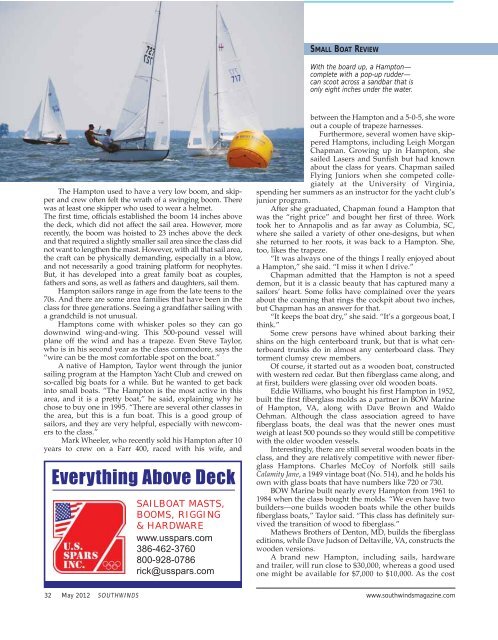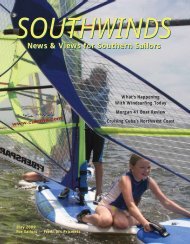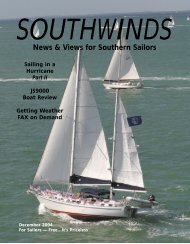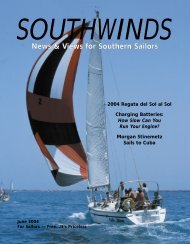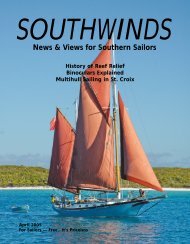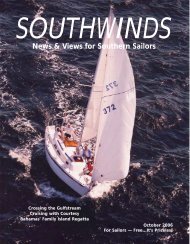News & Views for Southern Sailors - Southwinds Magazine
News & Views for Southern Sailors - Southwinds Magazine
News & Views for Southern Sailors - Southwinds Magazine
- No tags were found...
You also want an ePaper? Increase the reach of your titles
YUMPU automatically turns print PDFs into web optimized ePapers that Google loves.
SMALL BOAT REVIEWWith the board up, a Hampton—complete with a pop-up rudder—can scoot across a sandbar that isonly eight inches under the water.The Hampton used to have a very low boom, and skipperand crew often felt the wrath of a swinging boom. Therewas at least one skipper who used to wear a helmet.The first time, officials established the boom 14 inches abovethe deck, which did not affect the sail area. However, morerecently, the boom was hoisted to 23 inches above the deckand that required a slightly smaller sail area since the class didnot want to lengthen the mast. However, with all that sail area,the craft can be physically demanding, especially in a blow,and not necessarily a good training plat<strong>for</strong>m <strong>for</strong> neophytes.But, it has developed into a great family boat as couples,fathers and sons, as well as fathers and daughters, sail them.Hampton sailors range in age from the late teens to the70s. And there are some area families that have been in theclass <strong>for</strong> three generations. Seeing a grandfather sailing witha grandchild is not unusual.Hamptons come with whisker poles so they can godownwind wing-and-wing. This 500-pound vessel willplane off the wind and has a trapeze. Even Steve Taylor,who is in his second year as the class commodore, says the“wire can be the most com<strong>for</strong>table spot on the boat.”A native of Hampton, Taylor went through the juniorsailing program at the Hampton Yacht Club and crewed onso-called big boats <strong>for</strong> a while. But he wanted to get backinto small boats. “The Hampton is the most active in thisarea, and it is a pretty boat,” he said, explaining why hechose to buy one in 1995. “There are several other classes inthe area, but this is a fun boat. This is a good group ofsailors, and they are very helpful, especially with newcomersto the class.”Mark Wheeler, who recently sold his Hampton after 10years to crew on a Farr 400, raced with his wife, andEverything Above DeckSailboat Masts,Booms, Rigging& Hardwarewww.usspars.com386-462-3760800-928-0786rick@usspars.combetween the Hampton and a 5-0-5, she woreout a couple of trapeze harnesses.Furthermore, several women have skipperedHamptons, including Leigh MorganChapman. Growing up in Hampton, shesailed Lasers and Sunfish but had knownabout the class <strong>for</strong> years. Chapman sailedFlying Juniors when she competed collegiatelyat the University of Virginia,spending her summers as an instructor <strong>for</strong> the yacht club’sjunior program.After she graduated, Chapman found a Hampton thatwas the “right price” and bought her first of three. Worktook her to Annapolis and as far away as Columbia, SC,where she sailed a variety of other one-designs, but whenshe returned to her roots, it was back to a Hampton. She,too, likes the trapeze.“It was always one of the things I really enjoyed abouta Hampton,” she said. “I miss it when I drive.”Chapman admitted that the Hampton is not a speeddemon, but it is a classic beauty that has captured many asailors’ heart. Some folks have complained over the yearsabout the coaming that rings the cockpit about two inches,but Chapman has an answer <strong>for</strong> that.“It keeps the boat dry,” she said. “It’s a gorgeous boat, Ithink.”Some crew persons have whined about barking theirshins on the high centerboard trunk, but that is what centerboardtrunks do in almost any centerboard class. Theytorment clumsy crew members.Of course, it started out as a wooden boat, constructedwith western red cedar. But then fiberglass came along, andat first, builders were glassing over old wooden boats.Eddie Williams, who bought his first Hampton in 1952,built the first fiberglass molds as a partner in BOW Marineof Hampton, VA, along with Dave Brown and WaldoOehman. Although the class association agreed to havefiberglass boats, the deal was that the newer ones mustweigh at least 500 pounds so they would still be competitivewith the older wooden vessels.Interestingly, there are still several wooden boats in theclass, and they are relatively competitive with newer fiberglassHamptons. Charles McCoy of Norfolk still sailsCalamity Jane, a 1949 vintage boat (No. 514), and he holds hisown with glass boats that have numbers like 720 or 730.BOW Marine built nearly every Hampton from 1961 to1984 when the class bought the molds. “We even have twobuilders—one builds wooden boats while the other buildsfiberglass boats,” Taylor said. “This class has definitely survivedthe transition of wood to fiberglass.”Mathews Brothers of Denton, MD, builds the fiberglasseditions, while Dave Judson of Deltaville, VA, constructs thewooden versions.A brand new Hampton, including sails, hardwareand trailer, will run close to $30,000, whereas a good usedone might be available <strong>for</strong> $7,000 to $10,000. As the cost32 May 2012 SOUTHWINDS www.southwindsmagazine.com


